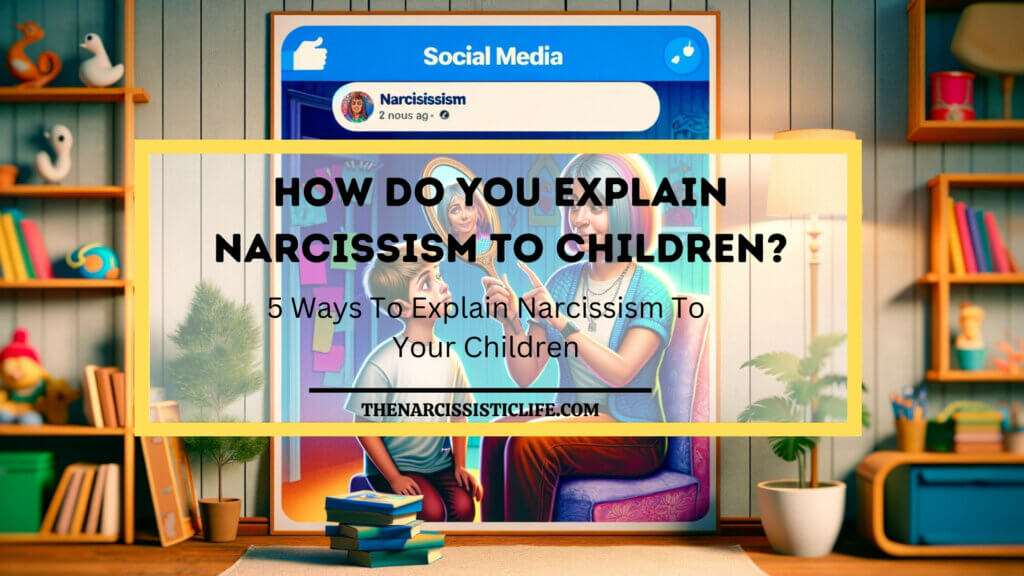Imagine you’re trying to explain the concept of a black hole to a goldfish; it sounds tricky, right? Well, explaining Narcissism to a child can feel just as daunting.
But don’t worry, it’s not as impossible as it sounds. You see, children have a remarkable ability to understand complex ideas when they’re broken down into simple, relatable terms.
The key is to find the right analogy, the right words, and the right timing.
Ready to crack this puzzle? Keep going because there’s a lot to uncover.

Why Explain Narcissism to Kids?
While it might seem challenging, explaining Narcissism to kids is crucial as it empowers them to understand and navigate social interactions more effectively, especially in a world heavily influenced by social media. Another obvious reason is, of course when a family member is a Narcissist.
Narcissism isn’t just about people being overly self-confident or conceited. It’s far more complex, often involving a lack of empathy and disregard for others’ feelings.
Your kid’s understanding of narcissism will assist in recognizing these traits in others, helping them develop healthier relationships.

It’s not just about labeling people but about understanding different personality types and how they affect interactions. And remember, it’s not their job to change a narcissist but to protect themselves from potential harm.
Apart from social scenarios, understanding Narcissism also helps kids differentiate between healthy self-esteem and destructive self-absorption. Celebrating their achievements and feeling proud is great, but they must also learn to respect and value others.
Explaining Narcissism to kids isn’t about creating fear or judgment but fostering empathy, understanding, and resilience. So, don’t shy away from this tough topic; arm your kids with the knowledge they need to navigate their social world confidently.
Simplify the definition of Narcissism
Let’s start with a simple definition of Narcissism, keeping it straightforward for a child to understand.
Suppose you’ve seen a person who loves looking at themselves in the mirror, thinks they’re the best at everything, and doesn’t seem to care about other people’s feelings. In that case, you’ve seen a glimpse of Narcissism.
Narcissism is like having too much of a good thing. It’s okay to love yourself, to be proud of your achievements, and to think you’re good at something. But a narcissistic person takes these things to an extreme.

They believe they’re better than everyone else. They’re so focused on themselves that they forget to care about others.
It’s important to understand that being narcissistic isn’t the same as having self-confidence. A confident person knows their worth but also respects others.
A narcissist, on the other hand, only values themselves and often puts others down to make themselves feel superior.
Use Drawings or Illustrations
To help visualize the concept of Narcissism, consider using drawings or illustrations to simplify this complex idea into something easier for a child to grasp.
For instance, you might draw a picture of a person looking into a mirror, completely absorbed, ignoring a friend trying to get their attention.
This can symbolize how a narcissist is so focused on themselves that they often overlook others.
You can also use illustrations from their favorite books or cartoons that showcase narcissistic traits.

Characters that always want to be the center of attention, disregard others’ feelings, or think they’re better than everyone else are examples you could point out.
Remember, it’s vital to keep the conversation age-appropriate. You don’t want to overwhelm your child with too much information or use images that might be disturbing.
Utilizing these visual aids can provide a concrete reference for abstract concepts, making explaining Narcissism more effective.
Kids are usually visual learners, so these drawings or illustrations can go a long way in helping them understand the nature of Narcissism and how to recognize it in real-life situations.
Apply Real Life Scenarios
Applying real-life scenarios can be a powerful tool in helping your child understand Narcissism. Imagine, for instance, a child in the park who insists on using the slide alone, disregarding others’ wishes to play too.
This child may be displaying narcissistic behavior. Discuss with your child how this scenario made the other children feel. It’s a simple, relatable situation that demonstrates the core traits of Narcissism: self-centeredness and a lack of empathy.

You can also use TV shows, movies, or books your child is familiar with to illustrate narcissistic behavior.
Take a character who always wants to be the center of attention, disregards others’ feelings, and believes they are superior. Walk your child through this character’s actions and discuss how it impacts others in the story.
Comparing Narcissism and Self Love
Understanding the difference between Narcissism and self-love is crucial for your child’s emotional development and self-esteem.
Narcissism is an excessive self-focus, often at the expense of others, while self-love is a healthy respect for oneself. It’s like appreciating a beautiful painting of yourself versus wanting every wall covered in your own portraits.
When explaining this to your child, emphasize that loving and being proud of oneself is okay.

It’s healthy to celebrate achievements and have self-confidence. That’s self-love. However, if someone constantly seeks validation, dismisses others’ feelings, and believes they’re superior, that’s Narcissism.
You can use simple analogies. Say, self-love is like a garden where various flowers bloom.
Each flower is different, but all are appreciated for their unique beauty. On the other hand, Narcissism is like a garden where only one flower is allowed to bloom, overshadowing and stifling all others.
Role Playing Games
Engaging your child in role-playing games can be a powerful tool to help them understand the concept of Narcissism.
It’s an engaging, interactive method that lets them learn by doing. Suppose you’re dealing with a doll or action figure, you can embody exaggerated narcissistic traits to showcase the behavior.
You might show how this character always wants to be the center of attention, dismisses the feelings of others, or constantly brags about their achievements.

Then, you can encourage your child to respond to this behavior. This hands-on approach can help them see the negative impacts of Narcissism firsthand.
It’s crucial to guide your child during these role-playing sessions. You should explain why the narcissistic character acts the way they do and reassure your child that this behavior isn’t healthy or kind.
Also, discuss how they might handle real-life interactions with narcissistic individuals, emphasizing the importance of empathy and understanding.
Conclusion
And there you have it! You’re now equipped to discuss Narcissism with your child in a way they’ll understand.
Remember, keep it simple, relatable, and interactive. Emphasize empathy, encourage open communication, and boost their self-esteem.
It’s not only about understanding Narcissism but also fostering resilience and empathy.
You’re doing a great job, and your commitment to these conversations will positively shape your child’s understanding of themselves and others.
Keep going!



